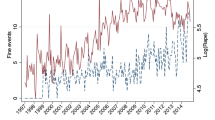Abstract
Both research and public policy efforts to determine levels of spouse abuse have been compromised, with significant incidence either uncounted or undercounted, owing to numerous factors: social stigma, victim guilt, evasive public policy, and sparse and/or technically inadequate research attempts. The CAPINDEX (Crimes-Against-Persons Index) is an estimation technique that tackles this persistent problem by using rates of well-reported violent crimes to predict the incidence of poorly reported violent crimes like spouse abuse. The numerical bases of the CAPINDEX, murder and aggravated assault, are well-reported and not subject to social class skewing. The relational approach of the technique is consistent with structural, cultural consistency, and ecological theories of violence. The technique is not only efficacious in estimating spouse abuse, but applicable to estimating sexual assault rates.
Similar content being viewed by others
References
Belsky, J. (1980). Child maltreatment: An ecological integration.Am. Psychologist 35: 320–335.
Bronfenbrenner, U. (1977). Toward an experimental ecology of human development.Am. Psychologist 32: 513–531.
Carrol, J. C. (1978). A cultural consistency theory of family violence in Mexican-American and Jewish subcultures. In Straus, M. A., and Hotaling, G. T. (Eds.),Social Causes of Husband-Wife Violence.
Connors, K. (1979).Psychogenic versus sociogenic sources of family dysfunction, Paper presented to the Department of Social Services, Baltimore, MD.
Coser, L. A. (1967).Continuities in the Study of Social Conflict, Free Press, New York.
Durkheim, E. (1951).Suicide: A Study in Sociology, Spaulding, J. A., and Simpson, G., Trans. Free Press, New York.
Garbarnio, J. (1976). A preliminary study of some cological correlates of child abuse: The impact of socio-economic stress on mothers.Child. Devel. 47: 176–185.
Gelles, R. (1975). The social construction of child abuse.Am. J. Orthopsychiatry, 47: 611–621.
Gelles, R. (1974).The Violent Home, Sage, Beverly Hills.
Gelles, R. (1980). Violence in the family: A review of research in the seventies.J. Marr. Fam. (November) 873–885.
Gelles, R., and Straus, M. (1979). Determinants of violence in the family: Toward a theoretical integration. In Burr, W. R., Hill, R., Nye, F. I., and Reiss, I. L. (Eds.),Contemporary Theories About the Family Vol. 1, (Chap. 21), Free Press, New York.
Houghton, B. (1979).Review of Research on Women Abuse, Paper presented at the annual meeting of the American Society of Criminology, Philadelphia, PA.
International Association of Chiefs of Police (1976).Wife Beating (Training Key 245), Gaithersburg, MD.
Langley, R., and Levy, R. C. (1977).Wife Beating: The Silent Crisis, Dutton, New York.
MacAndrew, C., and Edgerton, R. B. (1969).Drunken Comportment: A Social Explanation, Aldine, Chicago.
Maden, M. F., and Wrench, D. G. (1977). Significant findings in child abuse research.Victimology 2: 196–224.
Maryland Department of Health and Mental Hygiene, Center for Health Statistics. (1985).Poverty in Maryland: 1984, Baltimore, MD.
Maryland Department of Human Resources, Social Services Administration. (1986).Confirmed cases of child abuse and child sexual abuse, Baltimore, MD.
Maryland State Police. (1986a),Maryland battered spouse report 1985, Pikesville, MD.
Maryland State Police. (1986b).Maryland uniform crime reporting: 1985. Preliminary annual release, Pikesville, MD.
Merton, R. K. (1938). Social structure and anomie.Am. Sociological Rev, 3: 672–682.
Newberger, E. H., Reed, R. B., Daniel, J. H., Hyde, J. N., and Kotelchuck, M. (1977). Pediatric social illness: Toward an etiologic classification.Pediatrics 60: 178–195.
O'Brien, J. E. (1971). Violence in divorce prone families.J. Marr. Fam. 33: 692–698.
Pelton, L. G. (1979). Interpreting family violence data.Am. J. Orthopsychiatry 49: 194.
Potts, D., and Herzberger, S. (1979). Child abuse: A cross-generational pattern of childbearing?, Paper presented at the annual meeting of the Midwest Psychological Association, Chicago, IL.
Prescott, S., and Letko, C. (1977). Battered women: A social psychological perspective. In Roy, M. (Eds.),Battered Women: A Psychological Study of Domestic Violence, Van Nostrand Reinhold, New York, pp. 72–96.
Rounsville, B. J., and Weissman, M. A. (1977–78). Battered women: A medical problem requiring detection.Int. J. Psychiatry Med. 8: 191–202.
Sherman, L., and Berk, R. A. (1984). The specific deterrent effects of arrest for domestic assault.Am. Sociological Rev. 49: 261–272.
Snell, J. E., Rosenwald, R. J., and Robey, A. (1964). The wifebeaters wife: A study of family interaction.Arch. Gen. Psychiatry 11: 107–113.
Steinmetz, S. (1977).The Cycle of Violence: Assertive, Aggressive, and Abusive Family Interaction, Praeger, New York.
Steinmetz, S. (1978). Violence between family members.Marr. Fam. Rev. 1: 1–16.
Steinmetz, S. K., and Straus, M. A. (Eds.), (1974).Violence in the Family, Harper & Row, New York.
Straus, M. A. (1974a). Culture and social organizational influences on violence between family members. In Princi, R., and Barrier, D. (Eds.),Configurations: Biological and Cultural Factors in Sexuality and Family Life, Lexington Books-D.C. Health, Lexington, MA.
Straus, M. A. (1974b). Forward. In Gelles, R. J. (Ed.),The Violent Home: A Study of Physical Aggression Between Husbands and Wives, Sage, Beverly Hills, pp. 13–17.
Straus, M. A. (1978). Normative and behavioral aspects of violence between spouses: Preliminary data on a national representative USA sample. Unpublished manuscript.
Straus, M. A. (1979). Measuring intrafamily conflict and violence: The conflict tactics (CT) scales.J. Marr. Fam. 41: 75–86.
Straus, M. A. (1986). Domestic violence and homicide antecedents.Bull. N.Y. Med. Acad. 62: 446–465.
Straus, M. A., and Gelles, R. J. (1986). Societal change and change in family violence from 1975 to 1985 as revealed by two national surveys.J. Marr. Fam. 48: 465–479.
Straus, M. A., Gelles, R. J., and Steinmetz, S. K., (1980).Behind Closed Doors: Violence in the American Family, Doubleday, Anchor Press, Garden City, NY.
Walker, L. E. (1979).The Battered Woman, Harper and Row, New York.
Author information
Authors and Affiliations
Rights and permissions
About this article
Cite this article
Connors, K.A., Heisner, L. & Trickett, P. CAPINDEX: Abstract descriptors. Journal of Family Violence 7, 321–334 (1992). https://doi.org/10.1007/BF00994622
Issue Date:
DOI: https://doi.org/10.1007/BF00994622



